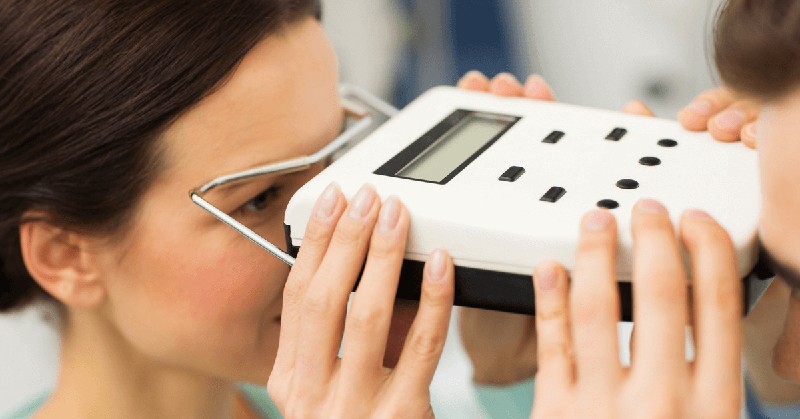
An ophthalmological department often employs a medical instrument known as a pupillometer. Visual issues and neurological illnesses are becoming more common due to the rising prevalence of vision problems and neurological disorders. Consequently, there is an increasing need for medical equipment that doctors may utilize to diagnose and treat various illnesses.
An eye pupillometer aids in comprehending the movements and dilation of the pupil in the eyes, and any divergence in the findings provides a hint as to whether or not the patient is experiencing a departure from the norm. The advancement of technology and its incorporation into the design of new medical equipment is creating waves in the area of medicine and is predicted to enhance the quality of healthcare facilities in the next few years.
What is a Pupillometer?
The term “pupillometer” refers to a group of two instruments. When used together, they can quantify the distance between pupils by using visual stimuli and the pupil’s reaction to the light reflex, which is both utilized in ophthalmology to diagnose and treat eye diseases. As a result of the light reflex, a programmable pupillometer is a portable instrument that may accurately measure the pupil’s size, pupil reactivity, and symmetry. In addition to being a non-invasive approach to assessing the pupil, it is also useful in pupillary evaluation to assess neurological function.
The role of the pupillometer in the healthcare industry
According to the findings of research using imaging modalities such as computerized tomography and magnetic resonance imaging, dilation of the pupil is directly connected to changes in the activity of the cerebral cortex. As a result, pupil dilation is useful in determining how a disease affects the normal function of the eye as well as how the activity of the brain is affected by the sickness.
Pupil dilation provides information about neurological illnesses and aids in the diagnosis of these disorders. It is beneficial in the development of psychological therapy. Pupillometers are often used in ophthalmology, cancer, and neurology, among other specialities.
Types of Pupillometer
- Digital: When it comes to measuring the size and activity of the pupil, the digital pupilometer is regarded as the most exact and rapid method available. With a digital pupilometer, even the smallest variations in the pupillary response may be detected and recorded. These frames are captured by the gadget in a matter of seconds and then computed and examined in order to estimate the dilation of the pupil.
- Video: It is a modified version of the standard pupillometer. It is useful in catching the whole range of pupil dilation activity, which is difficult to capture otherwise. Using this outcome, more investigation may be carried out in order to get a comprehensive knowledge of the changes and the factors that contributed to them. NeurOptics, an eye-tracking device manufacturer, has introduced new video pupillometers. These devices will be utilized both in critical care units and in applied research. Patients benefit from them because they help professionals provide them with better treatment.
Advantages of the Pupillometer
- When compared to EEG and MEG, the pupillometer is a more cost-effective alternative.
- It is a minimally invasive procedure to use.
- In ophthalmology, it is widely employed in the diagnosis of various conditions.
- It may be used to help in the diagnosis of neurological diseases.
Applications of the Pupillometer
This device is mostly used in hospitals and eye clinics to measure pupil size. In hospitals, pupillometers are being used in a variety of critical care units, including cardiac intensive care units, neurocritical care units, surgical intensive care units, medical intensive care units, trauma, paediatric intensive care units, and emergency departments, among others, to aid in the diagnosis of disease.
- Ophthalmology: It is becoming more common in eye clinics to use pupillometers to check for pupil dilation, which is useful in diagnosing illnesses of the retinal pigment epithelium. It is possible to evaluate the accuracy of the visual system’s operation by analyzing the pupillary light reflex. With the use of pupillometry, it is possible to detect variations in the response of melanopsin and photoreceptors in the eye, which may assist in determining whether damage has occurred to the inner or outer retina.
- Neurology: Any brain injury is connected with nerve damage, and this is shown by the disparity in the interpretation of the findings of the Pupillometer test. The Pupillary Light Reflex (PLR) is a useful tool in the evaluation of a wide range of neurological conditions. As previously stated, PLR evaluation is advantageous in analyzing the functioning of the oculomotor and optical nerves. If any divergence is seen in this examination, it implies that the central brain or intracranial tissues have moved horizontally.
- Oncology: A important tool in the evaluation of brain tumours is pupillometry, which may be performed in a variety of circumstances. It is necessary to utilize a pupilometer in order to determine the level of anaesthesia. In order to better comprehend different health diseases such as breast cancer, stroke, and thyroid tumour, much research is being carried out with the use of a Pupillometer. Several properties of the pupil, including the size and responsiveness to light, pupillary unrest, and other similar characteristics, are excellent indicators of various health issues such as head trauma or stroke as well as brain tumours.
Conclusion
The pupillometer market has seen tremendous expansion as the worldwide burden of neurological conditions, and visual impairment continues to rise each day. More eye care evaluation tools are needed to properly diagnose and treat these conditions. It is possible to get an insight into the lives of people with neurological illnesses by observing changes in their pupils’ diameter.

